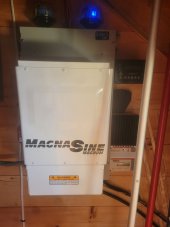Hi all,
I bought an off-grid house with a system already installed. I’m new to this and keen on learning more about my system so I can maintain it over time. I have outlined the setup below. My current batteries are dead/not holding a charge (Crown CR-235 deep cycle flooded). I want to purchase some LiFePO4 batteries (either Battle Born, Li Time or Renogy).
Before I purchase any of these batteries, I am unsure if my current system/setup is compatible with LiFePO4 batteries? I tried pulling up the operator manuals, etc. and it didn’t specify so wanted to check in here.
Current batteries: 8x Crown CR-235
Magnasine MS2024 inverter
Magnum energy MC-ARC50 Remote Control
TriStar Solar Charge Controller TS-M-2
Will this inverter, remote control, controller setup work with LiFePO4 batteries? Attaching a couple pictures of my setup if helpful too. Thanks!
I bought an off-grid house with a system already installed. I’m new to this and keen on learning more about my system so I can maintain it over time. I have outlined the setup below. My current batteries are dead/not holding a charge (Crown CR-235 deep cycle flooded). I want to purchase some LiFePO4 batteries (either Battle Born, Li Time or Renogy).
Before I purchase any of these batteries, I am unsure if my current system/setup is compatible with LiFePO4 batteries? I tried pulling up the operator manuals, etc. and it didn’t specify so wanted to check in here.
Current batteries: 8x Crown CR-235
Magnasine MS2024 inverter
Magnum energy MC-ARC50 Remote Control
TriStar Solar Charge Controller TS-M-2
Will this inverter, remote control, controller setup work with LiFePO4 batteries? Attaching a couple pictures of my setup if helpful too. Thanks!




